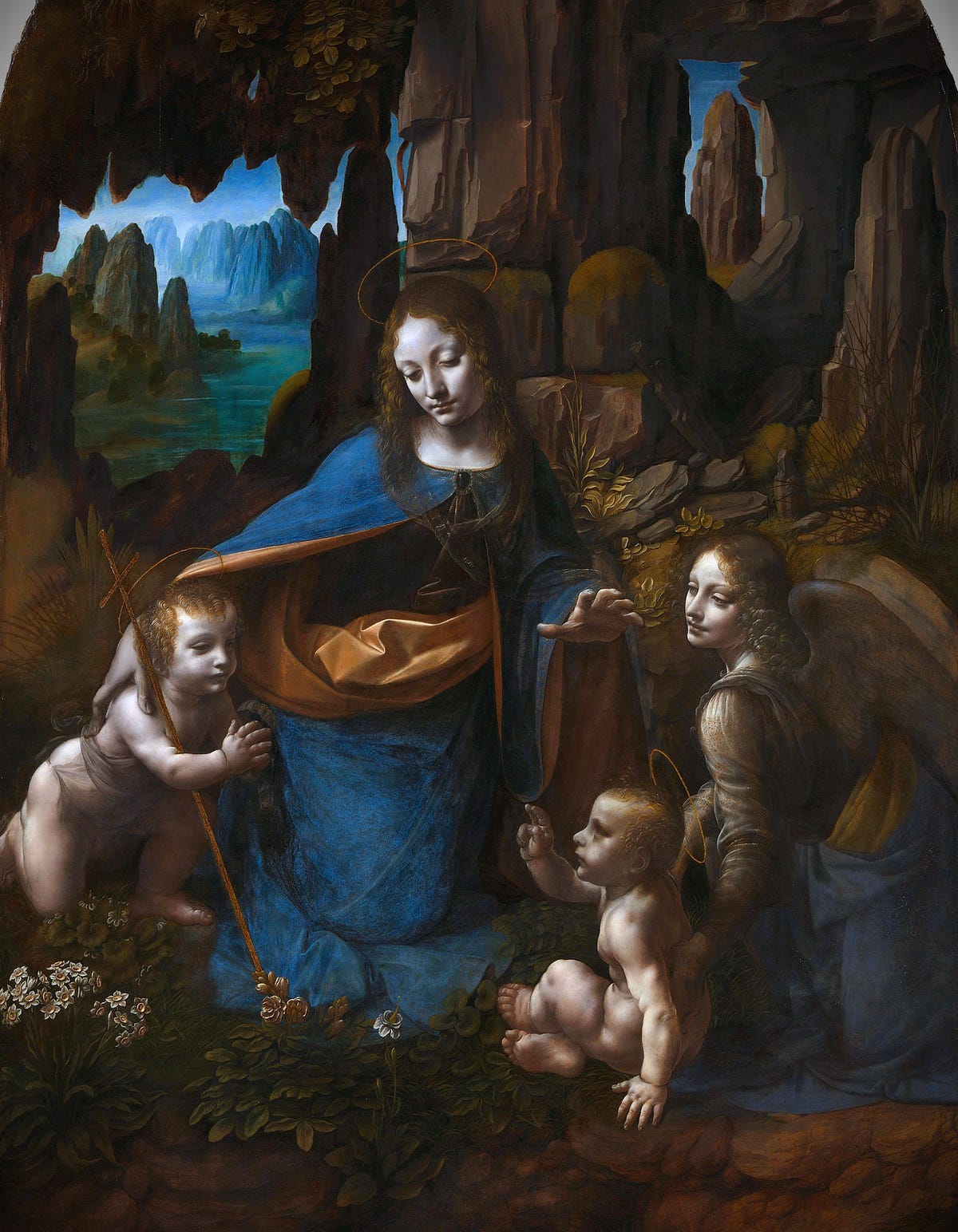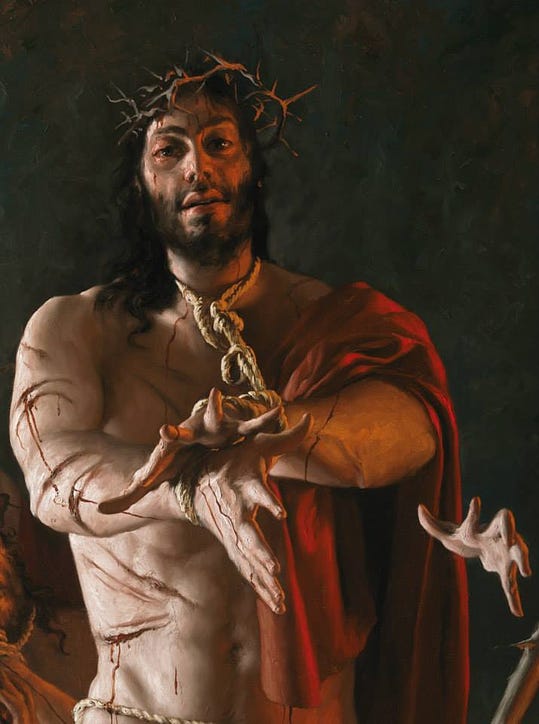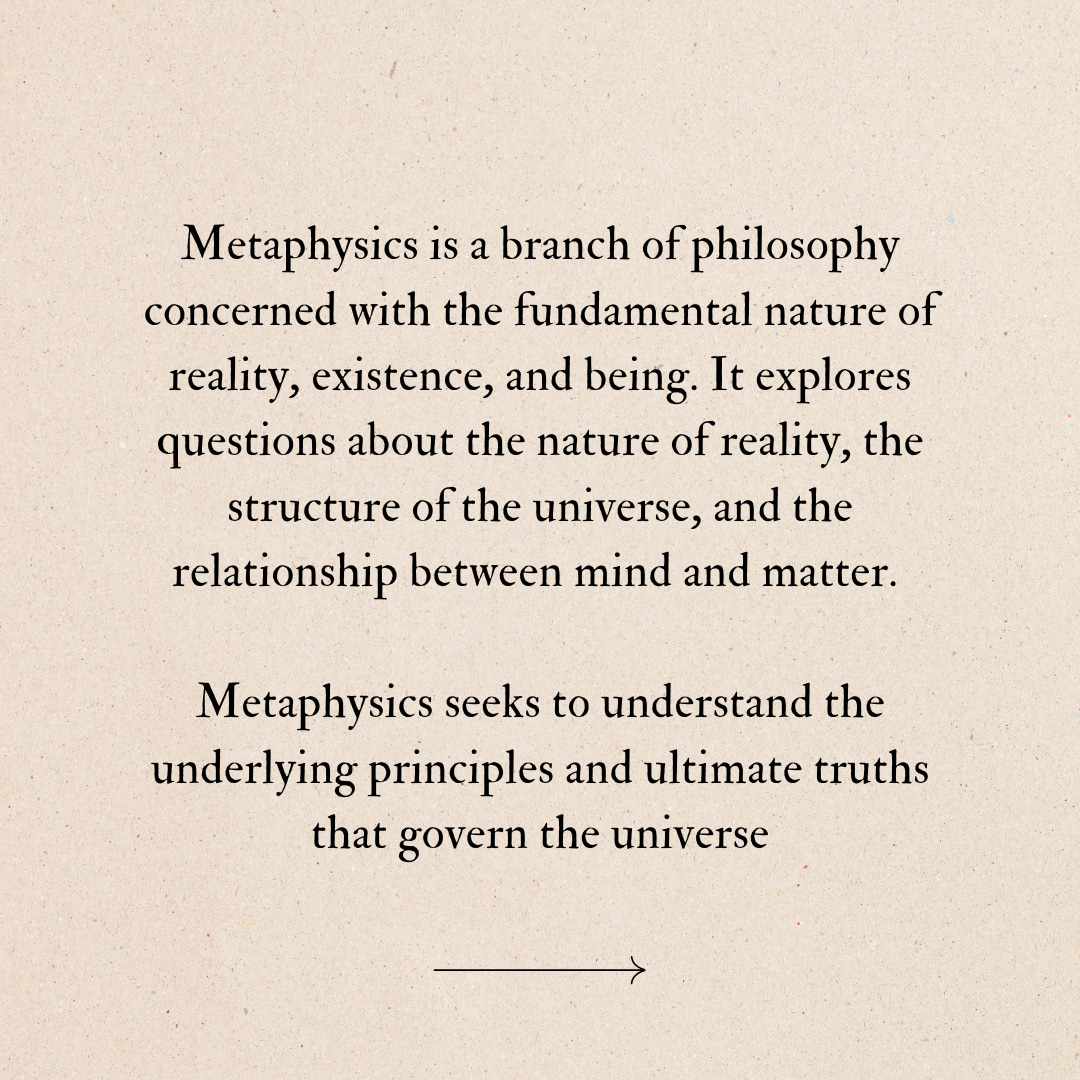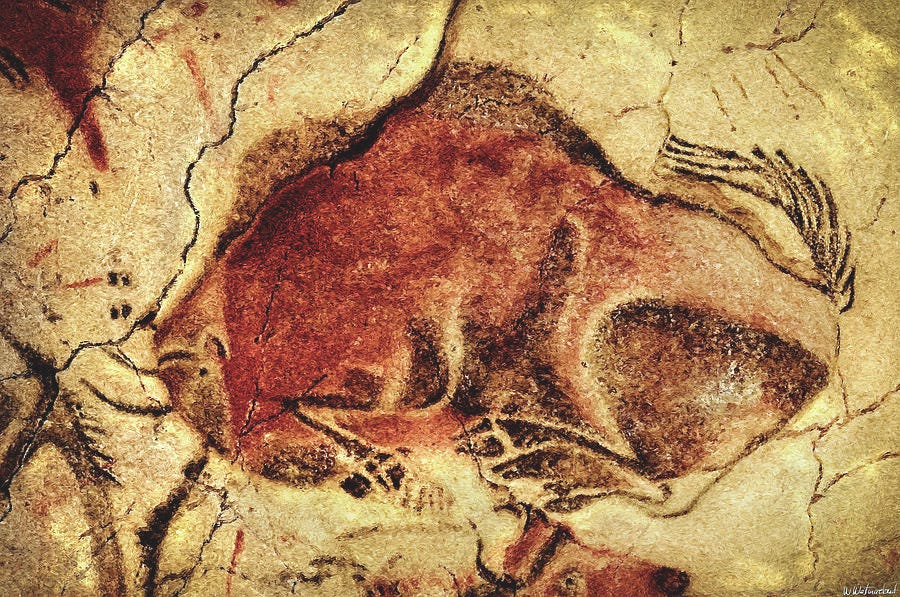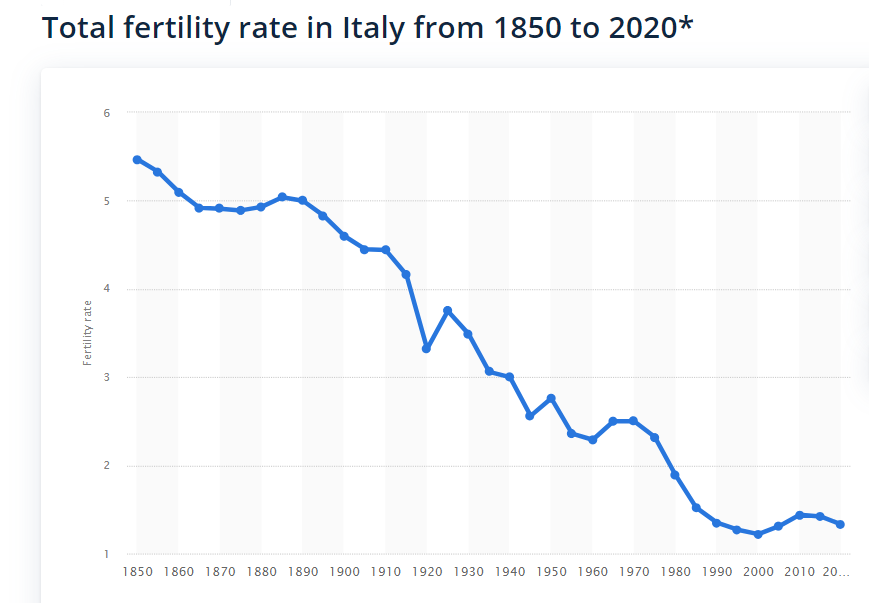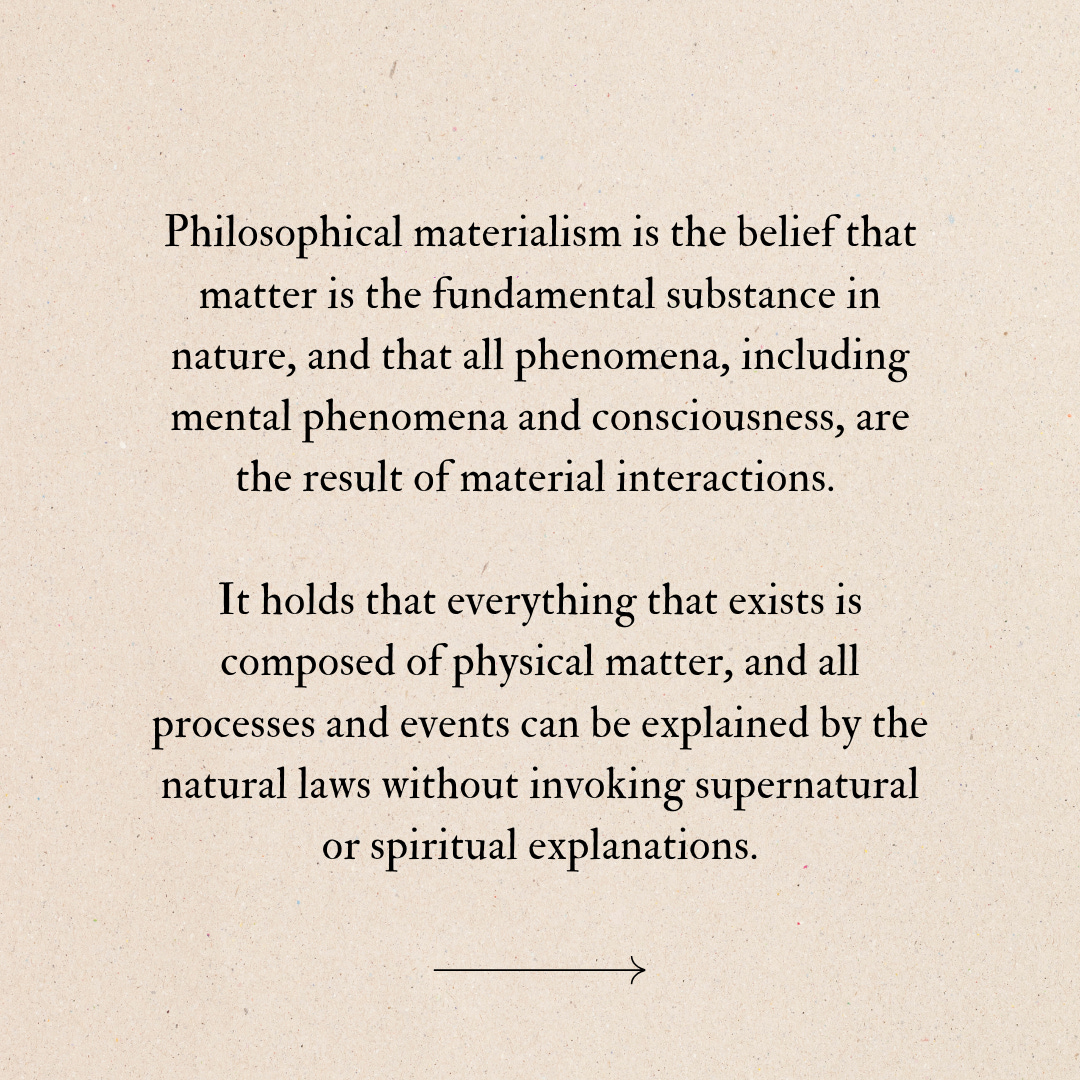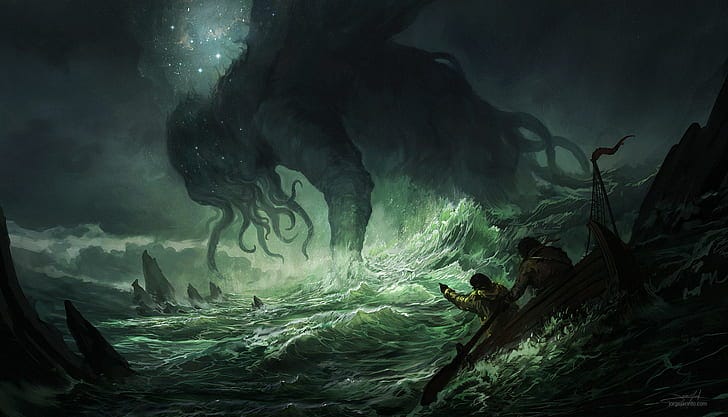From Giotto to Lovecraft: the long, slow, inexorable slope of materialist metaphysics
06-24-2024
From Giotto to Lovecraft: the long, slow, inexorable slope of materialist metaphysicsPart 3 of our series Gothic Devotion vs. Renaissance Humanism
In the last few weeks, we’ve looked at the differences in kind, in ontology, between Gothic sacred art and the visual output of the Florentine Renaissance. What it boils down to are two different, and fundamentally opposed, sets of proposals about the nature of God and the purpose of existence, in metaphysics. In today’s post we’re going to look directly at these different metaphysical proposals, both the healthy and the diseased, and maybe help to clarify how and why things have gone so very badly for Christendom since about 1500. And where we might be going from here if we stay on the same path. This was going to be a post for paid subscribers, but I think we need to get this one out there, so no paywall today. How did we get from the glories of the Renaissance to the disasters we’re in today? What are the connections? Find out below… But first a word from our sponsors: you! The Sacred Images Project looks at art history and culture through the lens of the first 1200 years of Christian sacred art.If you would like to accompany us into a deep dive into these spiritually and culturally enriching issues, to grow in familiarity with these inestimably precious treasures, I hope you’ll consider taking out a paid membership, so I can continue doing the work and expanding it.This is my full time work, but it is not yet generating a full time income. I rely upon subscriptions and patronages from readers like yourself to pay bills and keep body and soul together. You can subscribe for free to get one and a half posts a week. For $9/month you also get a weekly in-depth article on this great sacred patrimony, plus extras like downloadable high res images, photos, videos and podcasts (in the works), as well as voiceovers of the articles, so you can cut back on screen time.We are significantly further ahead in the effort to raise the percentage of paid to free subscribers than we were a month ago, from barely 2% to just over 4.5%, but this is still well below the standard on Substack for a sustainable 5-10%.The other way you can help support the work is by signing up for a patronage through my studio site, where you can choose for yourself the amount you contribute. Anyone contributing $9/month or more there will (obviously) receive a complimentary paid membership here.You can also take a scroll around my online shop where you can purchase prints of my drawings and paintings and other items.And now, back to our show… The sacred art of the Byzantine to the Gothic vs. the new Humanism of the RenaissanceAll our build up has been preliminary to proposing a kind of thesis: that there was a radical break in the underlying purpose, meaning and understanding between the religious art that we now call Byzantine, Romanesque and Gothic and the works we call the High Renaissance, these Old Master celebrity A-Listers, Leonardo, Michelangelo and Raphael, et al. Our thesis statements:
In all this writing we’ve been doing in our previous series “Lies the Renaissance Told you” parts one and two, we introduced this thesis, the notion that we are all suffering from a vast “philosophical confidence trick”. Man, the measure of all things? Another way to put it is to say that Renaissance Humanism, rejecting the notion of man’s dependence on a transcendent God had no answer for the questions, “Well, what are we for then? Who decides what’s good and what’s not good and by what criteria? How do we, who did not create the universe, assign objective value to things? How do we order our ideas about existence?” It laid an axe to the metaphysical foundations of Christian civilisation, and ushered in 500 years of war and moral chaos. What is Humanism and where did it lead?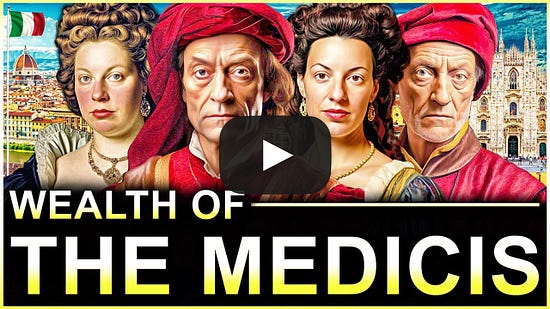 Renaissance art grew out of philosophical Humanism, promoted by a class of ultra-wealthy elites² interested in creating a new kind of world, one more compatible with their goals. As we discussed in a previous post,
This art became, as we know, immensely popular and in the west eventually completely supplanted all else until modern Christians, however well intended, now simply equate visual illusionistic realism with “good art”. But it had a much worse cultural effect of pushing the divine reality away from us and proposing that this world is the most important one. What place does darkness, illusion and deception have above a Christian altar? Think for a moment about that painting above, the Madonna of the Rocks, by Leonardo. It is not intended to show the mysteries of heaven, but proposes to be a scene in this world, shown to us by some illusionistic magic trick where the picture frame allows us to glimpse a moment from the past. The angel is only known as such by the wings, which are shrouded in shadow, and is otherwise completely fleshy. The background is of a landscape in this world and shows us nothing heavenly. The other figures are human, and very fleshy; there are halos but they are pro forma and barely visible. 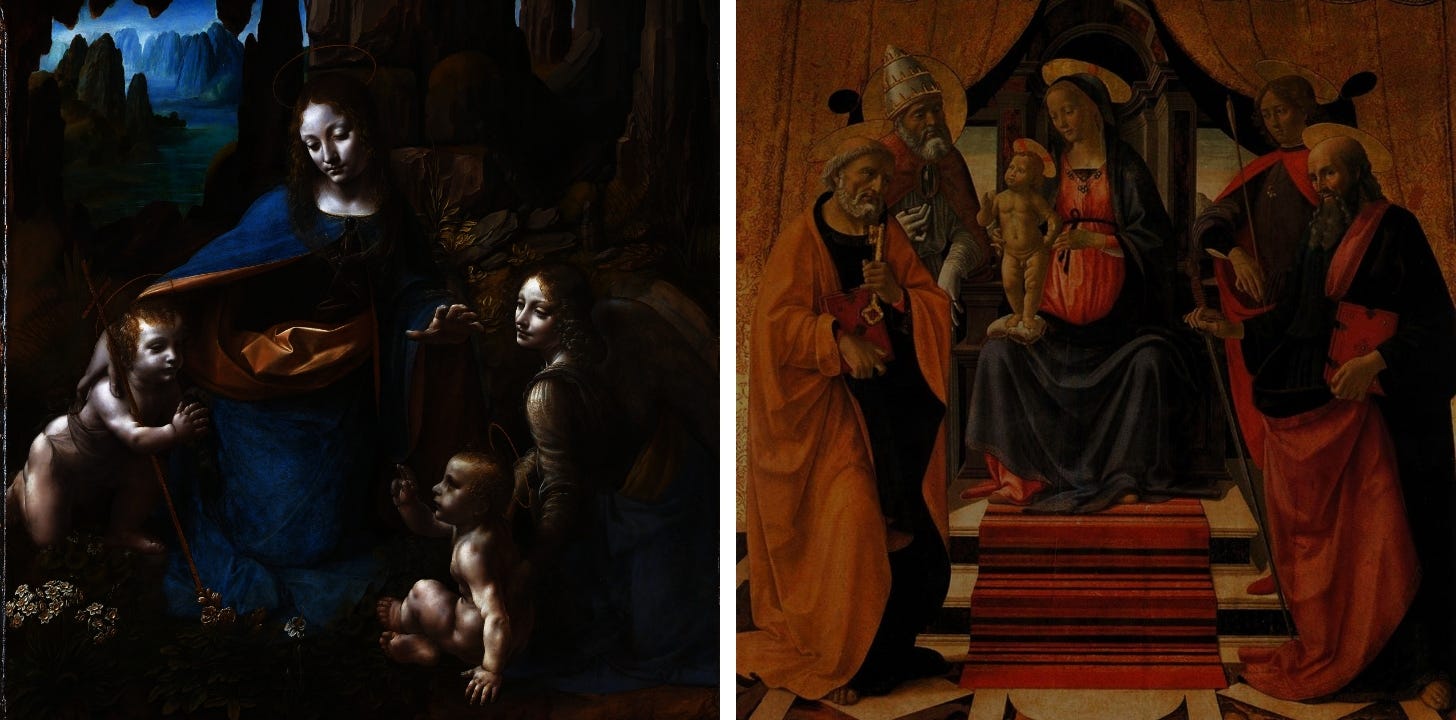 Bring the overall light level down using an image editor and you can see the difference. In the Leonardo the shadows engulf everything but the faces and flesh. In this Ghirlandaio sacred conversation, the light is evenly distributed on all the figures and background, so bringing down the light level the same way, and everything is still equally visible, with no dramatic, emotive wild contrasts. Ghirlandaio was a Renaissance painter but retained the purpose, the Telos, of Christian sacred art.
Most importantly, the light in the painting is the exact opposite of the standards of the earlier form - in which all the figures are bathed in heavenly light, there are no sharp value contrasts, no bright highlights or dark shadows, the figures and their clothes and other objects don’t cast shadows. All in the Leonardo is in darkness, with the chiaroscuro technique highlighting only the faces and flesh. This is illusionism - trickery and deception - emotional manipulation and the depiction of the darkness of the world - none of these has a place above a Christian altar where the Truth-become-Man is worshipped. This image cannot be venerated as a sacred object, a conduit or interface with heaven, but only revered as a famous thing. The new art fails its purpose and replaces the trueInstead of the icon as an inherently sacred object performing a real mystical function in the here and now, a holy conduit from heaven to earth and back, we have paintings by famous people that have become important not for what they are but for the notoriety of the people who painted them. Famous for their skill at illusionistic trickery, they show you an illusion of past events. The viewer looking at the Madonna of the Rocks is no longer a participant with a literal divine reality brought into the room with him, but an outsider looking through a kind of magical window or down a tunnel at events of the distant past in material history, with which he is not connected and cannot participate. He might have a sense of awe at the incredible level of skill of the painter, or if he is looking at it today, of awe at being the same room as a Leonardo, but he is having an emotional response, the same kind he gets by attending a concert by a famous rock star. This work cannot lead him to an authentic spiritual experience thereby. One of the effects of the Naturalistic revolution has been to leave us incapable of understanding the difference. What does the art tell us?This Renaissance bait-and-switch created a new kind of standard for artists; they must now pursue “originality” - a politer term than novelty - and compete with each other to achieve a place on the ladder of celebrity. It created the “career” of “artist” and destroyed the very concept of the painter as a craftsman devoted to the work of God. Once the “art market” for illusionistic mastery had been saturated, the pursuit necessarily took different directions, and we came finally, after the endless fragmentation of the “schools” and styles, to mere shock. Shock and outraging what remains of the normal sensibilities of viewers, is where the whole business has finally washed up. The ultimate end place of artistic naturalism is mere personal whim, solipsistic “self-expression” - the death of meaning itself. In the end, this has finally left us, after 500 years of artists chasing after the “latest thing” for cash and celebrity, languishing in a deracinated visual cultural landscape. Western Christians are left with no grounding to make determinations about the value of their art, and have no idea how sacred images were originally intended to be integrated into their spiritual lives. The idea that the images were there to help them reach union with God is long forgotten. In the western Church we have the depressing situation where the visual standards established by Renaissance Naturalism have, in an entirely logical progression, given way to the visual language of fashion magazine photography. Leading finally, in the uttermost extremity of our current spiritual collapse, to … whatever this is supposed to be … placed above our altars…
The proposal, the fundamental idea, behind the two kinds of work are not merely different but radically opposed. Put the Madonna of the Rocks - or that horrific Gasparro thing - over your altar if you want, but looking at it you aren’t doing the same thing spiritually as our Byzantine, Romanesque and Gothic spiritual ancestors were doing - you’re just looking, not venerating. Why metaphysics is more important than politicsTo understand these issues it is not enough to keep abreast of secular or ecclesiastical politics, or the ins and outs of the art world. It’s not even enough to know more than the average person about recent history. Our current malaise goes back in a different direction. It isn’t a corruption of politics or religion; it is a corruption of the thing that precedes those things: metaphysics. There is a direct philosophical line between Renaissance Humanism and the 18th century Materialism that has, in the last 250 years, eaten all of Christian culture and left us languishing in our current sea of cultural and philosophical toxicity. Renaissance Humanism, a set of social ideas, is based on an essentially materialist metaphysics, and played a crucial role - not at all by accident - in the radical transformation of Western thought. Transcendence vs. Materialism
Our problems in the Church and the secular world are finally reaching a kind of crescendo of catastrophe and are spawning some results so bizarre that if you had a time machine you’d probably only have to go back five years to find someone who would not be able to believe your recitation of current events. But how did we get to this insane pass? How did the catastrophic loss of faith occur in the churches around the world? No, really… how did that happen? Because there seems to be no historical or even archaeological precedent for any human society ever being entirely and deliberately non-religious and anti-transcendence as ours has become today. Art communicates what a society is about. Every indication we have from every archaeological record we’ve found is that we are the first human society to ever entirely reject the transcendent and adopt pure materialism. The art of every previous society we’ve ever heard of not only captured the image of physical reality but suggested a connection between the natural world and higher, transcendent reality. And now, after five centuries of materialism in art and thought, we’re wondering why there is an “epidemic of depression” and existential anxiety, and why the demographic clock is running out for most developed nations. Meaning and the pursuit of transcendence is more important than we thought; it gives us a reason to continue to live. We are a global civilisation that has, quite literally, no reason to continue to have children, to continue to exist as a species into the future beyond our immediate moment. Materialism found fertile ground in the intellectual climate fostered by Renaissance Humanism and its art that acted as public propaganda. The Humanist revival of the works of the early pre-socratic philosophers, atomists like Epicurus and Lucretius, reintroduced materialist ideas to a broader audience. Epicureanism proposes that the world is made of physical phenomena, atoms and there's no afterlife or transcendent reality outside the material, so we should focus on dismantling anxieties about death and pursuing simple, sustainable pleasures. It’s easy to see how a philosophy like this would appeal to a man like Cosimo de Medici. By adopting mere human experience³ and observation of the material world as the standard for how we know things (epistemology), Renaissance Humanism rejected transcendent reality entirely by simply denying its existence or at least suggesting it isn’t terribly important. Its adoption by the institutions and elites, especially as it appeared on the edge of certain discoveries and technological advancements like the printing press and navigation equipment that allowed the colonisation of the New World. These developments led to the aerosolising of a worldview in which the physical and material are the primary, if not the only, constituents of reality. This transition was essential in shaping the philosophical landscape we live in today and gave room ultimately for the rise of our current technocracy and all that goes with it.⁴ It’s the great irony that the Humanistic movement of the late 15th century has reached its final, monstrous form in our contemporary wildly anti-human, anti-biological-reality social trends. But once we know the real names of these ideologies, their true nature becomes clear. Lovecraft’s Nihilistic Cosmicism; materialism’s final formWe’re going to switch gears here and take a look at materialism’s effects on a different kind of art. H.P. Lovecraft was an American writer whose weird and sci-fi horror speculative fiction is characterized by an expression of the extreme, final logical conclusion of Humanism and its idiot child, 18th century Materialism; cosmic nihilism. His work is widely thought to be among the most frightening ever written in English, and we’re going to examine why. 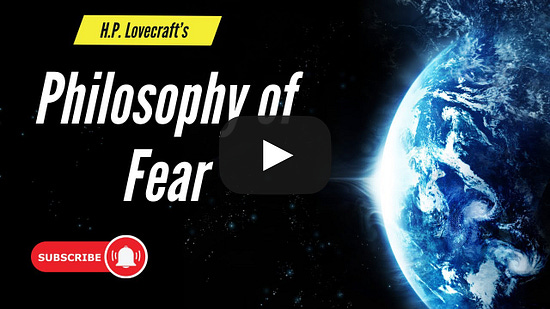 Lovecraft suggested a kind of metaphysics of “cosmic indifference” in which there is not only no transcendent God; there’s no meaning or purpose to existence at all. Reality is entirely meaningless and Lovecraft’s “gods” are enormous ancient and malevolent monsters from deep space, so indifferent to us and our needs or hopes that we are less than food animals to them. Humanity is insignificant in the cosmos, having come into existence for no reason and as a result of no outside agency, and humans are powerless against the immense and often malevolent forces beyond their understanding. In Lovecraft’s materialist metaphysics of total meaninglessness, all philosophy, even all science, is pointless and all religions merely shams, a gloss of falsehoods human beings invent to shield themselves from the knowledge of the terrible truth. The working principle - if it can be called that - is nihilism, where traditional beliefs and values are rendered meaningless by the discovery of the true nature of reality. Characters in his stories frequently encounter entities or knowledge that shatters their perception of the world, leading to madness, despair and suicide. Much of the horror aspect of his work comes from his ability to imaginatively subvert the nature of reality. Lovecraft often describes his evil gods living in a world of “alien geometries” that make no sense in ordinary reality and “architectures” that defy the principles of Euclidean geometry.⁵ All these factors evoke a sense of fundamental emotional and intellectual disorientation, reinforcing the idea that the universe operates on principles that are fundamentally alien to human experience. The Lovecraftian universe is one that is incapable of sustaining anything a human being could conceive as meaning. From Naturalism to Materialism to Lovecraft: “The result was only ruination and despair…”Yes, from the 18th century there is also a straight line between philosophical naturalism and materialism and Lovecraft's terrible scream of existential agony. They all share a focus on the material, proposing an indifferent, mechanistic universe and a rejection of meaning. Humanism is fundamentally materialistic, which implies a spiritually empty, deterministic universe governed only by natural laws, founded by no conscious agency. In this universe not only is there no redemption for sins, there’s no need to desire such a thing. Morality in such a universe is as meaningless and arbitrary as everything else. Lovecraft's work strips away the Renaissance’s rosy fairy tale of a moral Humanism that elevates man to the status of a demi-god gaily deciding on his own values and meaning. The existential dread, horror and despair at the heart of his work comes from simply following the naturalist/materialist Humanist logic to its conclusion; making ourselves the measure of all things has turned us into monsters. Man must worship something; if he worships himself he becomes a “horror beyond all comprehension”. What’s that conclusion? That the Meaningless Universe proposal, and the insanity it leads to, is the dark tentacular horror crouching quietly in the core of Humanism’s pretty flowers. It starts out attractively enough, but the ideas all lead down a long slow slope to unimaginable cosmic horror from which the human soul instinctively recoils. It’s just taken this long for all the sweet talk to fall away. And the reality is being revealed every day in our daily news headlines. Do not desire it, Miss Dashwood.
1
Telos is the Greek philosophical term for a thing’s ultimate inherent purpose, implying that the thing has a willed purpose built into its very nature.
2
I don’t know how exactly one calculates something like this, but it seems clear that the Medicis were about the richest people who ever lived. The video I linked here says they were worth the modern equivalent of 6.4 quadrillion US dollars, which is more than the GDP output of the entire human race today. I don’t know how accurate it is possible to be with something like that, so make of that what you will. Suffice to say that as the people who pretty much invented money, finance and banking, it could be said they invented being rich. No one has ever come close, before or since.
3
All lawyers will tell you how unreliable eyewitnesses are, which is why legal determinations are not made based solely on their testimony.
4
Government, rule or control of society by an elite of technical “experts” who are considered unbiased and naturally honest and incorruptible. For how well that works, cf: the whole world between 2020 and 2024.
5
If you ever want to study a scientific subject that will show you the underlying shape of reality; Euclid. You’re currently a free subscriber to The Sacred Images Project: Early Christian Art and Culture. To see all the posts, deep dives, videos, chats and receive access to special downloads, upgrade your subscription. It’s just $9/month. |

